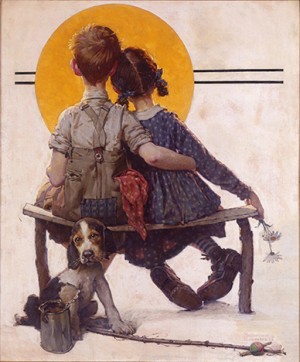“Boy and Girl Gazing at Moon (Puppy Love)” Donated to Museum’s Permanent Collection

Norman Rockwell (1894-1978), “Boy and Girl Gazing at Moon (Puppy Love),” 1926. Cover illustration for “The Saturday Evening Post,” April 24, 1926. Oil on canvas. Norman Rockwell Museum Collection/Given by Bill, Casey, Maggie, Jenny, and Jessie Millis in honor of Norman Rockwell, an incredible American. SEPS: Curtis Licensing, Indianapolis, IN
Stockbridge, MA, February 13, 2015—Norman Rockwell Museum announces the recent acquisition of Norman Rockwell’s 1926 painting, “Boy and Girl Gazing at Moon (Puppy Love)” to its permanent collection. One of Rockwell’s most iconic images, “Boy and Girl Gazing at Moon” was donated to the Museum as a gift from Bill, Casey, Maggie, Jenny, and Jesse Millis, “in honor of Norman Rockwell, an incredible American.”
The early Rockwell painting was created for the cover of the April 24, 1926 issue of “he Saturday Evening Post” and has resurfaced in recent years in the form of artistic homages and parodies. It was the inspiration for a very popular Google Doodle, presented by the web search engine in honor of Rockwell’s birthday on February 3, 2010, resulting in over three million worldwide visits to the Norman Rockwell Museum website. The painting is now on view at the Museum, located in the artist’s hometown.
“We are extraordinarily grateful for the generosity of the Millis Family. Their magnificent gift ensures that this beloved Rockwell work will delight generations for years to come,” notes Norman Rockwell Museum Director/CEO Laurie Norton Moffatt. “Painted early in Rockwell’s career, ‘Boy and Girl Gazing at Moon ‘holds all the hallmarks of Rockwell’s genius, revealing his keen observation of human nature and gentle humor. The painting deepens our holdings of the world’s largest collection of original Norman Rockwell art, helping us tell the nation’s story through pictures.”
Despite the record-breaking prices that original Norman Rockwell art is receiving at auction today, Bill Millis remembers paying far less for the work back in 1975: “I loved everything Rockwell had painted—for me it’s what America stood for,” recalls Millis from his home in High Point, North Carolina. “Little did I know how popular Mr. Rockwell was, but I’d write him and he’d always write me back. I asked him if he knew whether any originals would ever be for sale, and he told me that there was going to be a showing at the Bernard Dannenberg Galleries in New York City.”
Millis traveled to New York and met with the gallery’s curator, who showed him the works on view. “I was just in awe of the Rockwell paintings, and all of the sudden I saw this one, Puppy Love, and I asked if it was for sale, and he said it was, and I said ‘Oh my goodness!” Then only 26 years old, Millis asked the curator if he could hold it for him until the following Monday when he could send a check, to which the curator agreed. The 24″ x 20” oil on canvas has hung proudly in the Millis household for the last 40 years.
“Over the years I have debated what to do with the painting,” notes Millis, who has observed the rising value of Rockwell works. “So I decided to gift it to the Museum. I thought I can go ahead and visit the Museum while I’m still alive, taking my children and grandchildren. I’m just thrilled that the painting is going to be there in the Museum. I actually wrote Mr. Rockwell a letter and told him I had purchased it, and I remember him writing me a letter back saying, ‘I’m glad Puppy Love finally has a happy home.’ Now it will be at home at the Museum, where hopefully thousands of people can also view it.”
About “Boy and Girl Gazing at Moon (Puppy Love)”
Life’s simple pleasures and the blush of first love are the focus of Norman Rockwell’s 1926 “Saturday Evening Post” cover, which portrays a young couple entranced by the moon, and by each other’s company. Their rickety wooden seating bends under their weight but does not deter them from their reverie, for they are taking time to enjoy the moment.
In 1926, Rockwell had already been working for “The Saturday Evening Post” for ten years. A self-proclaimed specialist in painting child-centered scenes, he elevated the status of his youthful subjects by portraying them as complex individuals with dignity, despite their economic status. In this work, Rockwell recalls the pleasures of spending vacations on rural farms on Long Island and in upstate New York, a respite from the bustle of life in New York City, where he was born and spent his youth. His composition invites us to peer over the shoulders of the children who are not aware of our presence. Their simple fishing gear—a branch equipped with line and a blue and orange bobbin (which repeats the artist’s color palette)—has been placed down behind them. Enrapt as they are, they are not aware that their bait is escaping from the can, or that the dog, now a third wheel, gazes longingly out from the canvas.

